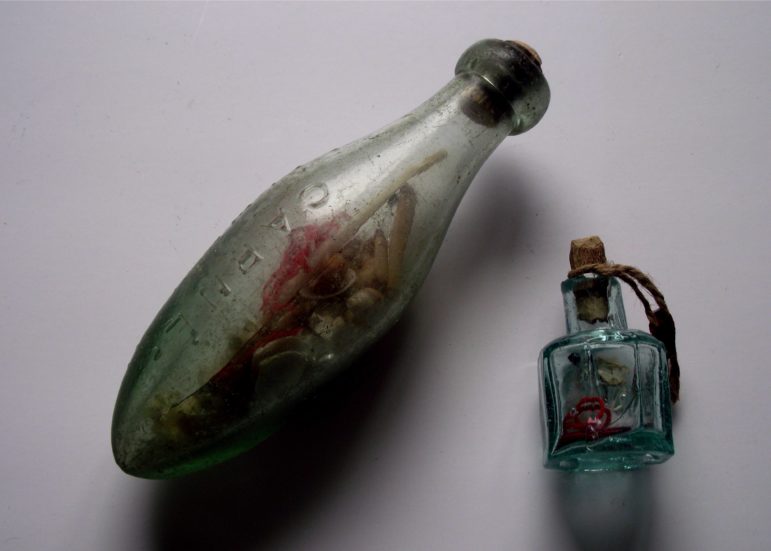LONDON – The United Kingdom Arts and Humanities Research Council is currently funding a project based on witch bottles, in an effort to understand more about this type of practice. It’s being helmed by Museum of London Archaeology (MOLA), “an experienced and innovative archaeology and built heritage practice” and MOLA’s finds specialist Nigel Jeffries is in charge, along with Owen Davies, and Ceri Houlbrook from the University of Hertfordshire – both experts in the history of witchcraft and magic.
Witch bottles still turn up in older houses across Britain, dating from earlier times: they are typically filled with pins, coils of wool, tangled threads, nails, needles and, sometimes, human urine. They are supposed to attract negative spells, which become tangled in all the mess in the bottle and can’t get free – a bit like a dark dream-catcher. You can make a specific witch bottle for a person: put their name in it, fill the bottle with pins, wool, and ideally something intimate from the intended target.

[17th century Bartmann bottle – image credit: D. Herdemerten (Hannibal21)]
The first witch bottle to be treated scientifically in the UK was found in Greenwich in 2004 and as well as urine, contained navel fluff, nail clippings and a leather heart pierced with a nail, as well as traces of iron sulphide (suggesting that brimstone or sulphur had been included in the bottle). The nail clippings appeared manicured, suggesting to the researchers that someone of quite high social standing had been involved in the creation of the bottle.
“So many have been dug up and their contents washed away down the sink,” says Alan Massey, a retired chemist formerly at the University of Loughborough, UK, who undertook a study of the Greenwich bottle. He goes on to explain that
“The idea of the witch bottle was to throw the spell back on the witch. The urine and the bulb of the bottle represented the waterworks of the witch, and the theory was that the nails and the bent pins would aggravate the witch when she passed water and torment her so badly that she would take the spell back off you.”

[Witch bottle – image credit: The Portable Antiquities Scheme/ The Trustees of the British Museum]
MOLA describe the most common form of witch bottle as “bulbous, beardy and brown,” noting that, “Most are durable German-made Bartmann stoneware jugs or bottles, which tend to be brown, bulbous and decorated with characteristic bearded facemasks and applied roundel medallions. These vessels, made in Frechen close to the city of Cologne, were the most common and widely traded pottery type of early modern Europe. Later in the 17th century similar vessels made by the first English stoneware pothouses…were also used.”
MOLA recently found such a bottle carefully placed under the tiled floor of an 18th century house in Shoreditch in London: it is typical for witch bottles to be found under floors, at thresholds, or in chimneys. The Shoreditch bottle, which is ceramic, is of a type dating from 1670 – 1710 and contained 60 or so fine bent copper alloy pins with wound wire heads, some rusty nails and a piece of wood or bone. The construction of witch bottles was at its height at the time of the witch trials, but continues today.
MOLA says, “The practice of using charms seems to have continued to the present day, with a small plastic medicine bottle found on the Thames foreshore in 1988. It was recently opened at the Museum of London’s Archaeological Archive by conservators and found to contain a halfpenny, a dime, teeth, a wrapped piece of metal and a small bottle of what may be oil of cloves…”

[Witch bottles – image credit: Malcolm Lidbury (aka Pinkpasty)]
The project also involves extensive research to situate the practice in its full historic context, including its origins, how ‘bottle magic’ spread and was adapted in subsequent centuries, the types of locations in which it is found, and its relationship to early modern medicine and popular magic and how these were practiced and understood.”
MOLA also gives instructions to anyone who finds a witch bottle on their premises, and they’re keen to hear from you if you do:
- ‘Witch bottles’ are covered by the Portable Antiquities Scheme, so most importantly, please contact your local Finds Liaison Officer based at your county museum and await their advice.
Treat it as an archaeological find: if you can, please don’t move it – keep it in situ until it has been validated and reported. Record the position it was found in, take photographs and resist cleaning it. - Similarly if it is corked or stoppered then please don’t remove this. As described, a bottle may have contents.
- If it has already been moved or un-stoppered in the past, we would still be really interested in hearing about it.
- Report your find to the ‘Bottles Concealed and Revealed’ team
→ By email, at witchbottles@mola.org.uk
→ On Twitter or Facebook, by tagging @MOLArchaeology and using the hashtag #WitchBottleHunt
However, we may note that one witch bottle, donated to the Pitt Rivers collection, was said by its inheritor to hold an actual witch, and must never be opened in case she got out – a different kind of witch bottle altogether!
The Wild Hunt is not responsible for links to external content.
To join a conversation on this post:
Visit our The Wild Hunt subreddit! Point your favorite browser to https://www.reddit.com/r/The_Wild_Hunt_News/, then click “JOIN”. Make sure to click the bell, too, to be notified of new articles posted to our subreddit.
